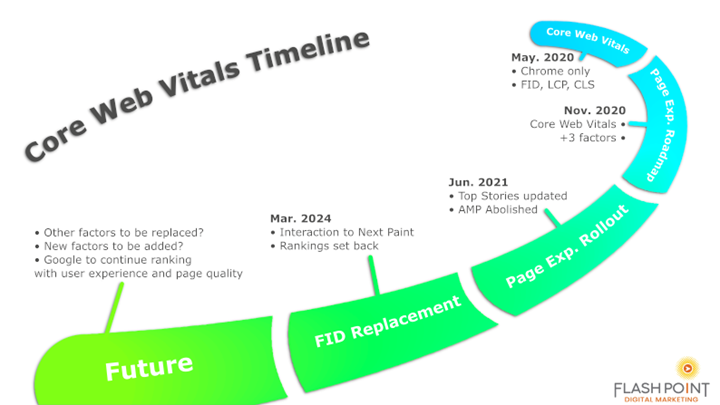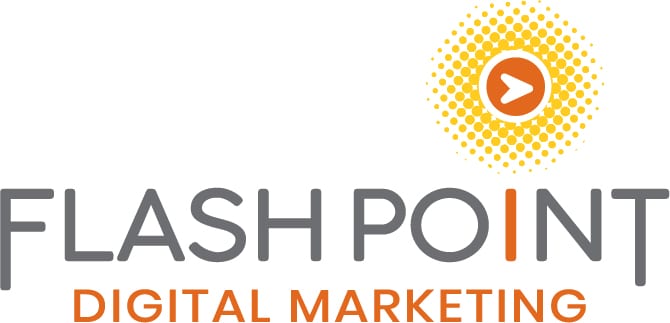SEO Guides, Tips & More!
Learn from Our ExperienceThe History and Future of Google Page Experience
Google page experience is one of the most important, if not the most important, ranking factors in the Google SEO space. For that reason, it’s important to cover it in-depth and walk through its history. I’ll be going over when and why Google page experience started, how it works broadly, and cover future directions or concerns. Let’s get started.
What is Google page experience?
Currently, page experience is an amalgam of signals, three of which fall under the category of core web vitals. They are, in order of listing of the official Google Search Central Page:
- Largest Contentful Paint (LCP) – the amount of time for the largest content to load and be ready for interaction, only measured above the fold (the largest content visible without scrolling further on the page). It only counts images, image tags, thumbnails, and text elements. The ideal measure is roughly under 2.5 seconds, with 4 seconds denoting a need to improve, and over 4 seconds denoting a poor score.
- Interaction to Next Paint (INP) – this measures the delay between the user input and when the frame appears on the user’s screen. This will soon be replacing first input delay (FID), which only measures input to the browser response and is only valid for the first interaction.
- Cumulative Layout Shift (CLS) – sometimes pages have elements that move when new elements are added asynchronously or dynamically. The union of space between the original position of an element and the new position of the element as it moves is multiplied by the shift (both relative to the viewport size) to create a number for this ranking factor. A good ranking should be less than 0.1 and anything over 0.25 is considered poor.
- HTTPS or hypertext transfer protocol secure is also considered as part of page experience. Making sure to switch from HTTP will make an impact, especially when Chrome can designate your site as unsecure.
- Interstitials are a particular type of content element primarily used for advertising purposes. Overlaying these on a main page or other such practices intrusive to the user experience are tracked by Google and counted against the site.
- For mobile sites, the general optimization and usability of the site is also considered part of good page experience.
There is no exact number or formula that calculates a page experience score per se, but rather a general assertion is made about a URL’s page experience being either good or bad depending on each of these individual factors. The best way to get a sense is by looking at the page experience report through a property on Google Search Console, or by using PageSpeed Insights.
Where did it begin?
Page experience was initially discussed all the way back in May of 2020 when Google shared a skeletal roadmap towards implementing page experience for mobile and taking away Accelerated Mobile Pages from Top Stories eligibility in favor of it. Google had previously announced core web vitals and added new factors to create a “holistic picture” of user experience. On November 10th of that year, the official 2021 roll-out was announced, which started in June and ended in August. Page experience has been going strong ever since, with the most recent notice being the rollout of INP in March 2024.
Where will it go in the future?
While it’s impossible to predict the future, it’s important as an SEO specialist to anticipate directions in which Google may take its ranking factors such as page experience. Let’s look at where it could go in the future:
- Accessibility is an important part of including every user’s experience into page experience and it could easily become a core part of ranking on SERPs. One simple way this might be achieved is through a guideline or standard such as the Web Content Accessibility Guidelines (WCAG). Some of these are already best practice for websites such as alt text on most non-text media, alternatives for audio—only and video-only content, and captions where applicable.
- AI could be used to better understand page experience factors. For example, layout shifts could have their impact weighted differently depending on the context of the user session, which may only be feasible with AI technology.
- More complex user behavior measures could easily be added in, such as pogo-sticking or page dwell time. This could tie into AI to determine user interest as part of page experience.

Conclusion
In an ever-changing search engine landscape, keeping up with every last nuance is impossible. Despite that, major ranking signals such as those present in page experience are always worth keeping track of. Especially the FID replacement announcement, which will undoubtedly shift the way SEO professionals have to approach page experience going forward.
As this change rolls out, it’s vital for experts to keep a look out for other modifications Google may look to going forward. Google began by hinting about ways FID could be improved, then took a step to improve the concept. This means that Google could just as easily consider other changes of varying size to improve its read on UX.
One simple philosophy to better prepare for these changes is to approach SEO with only best practices and holistic practices in mind; those who made sure to optimize their site fully will have far fewer issues with the change. By seeing where the timeline was with Page Experience, we can get a better sense of how and when Google will roll out other major (public) additions to its search algorithm. And with all these ideas in mind, you have the toolkit to effectively plan for both Google page experience and the ways it or other factors might change in the future.
Reach out
In an ever-evolving SEO landscape, it’s both necessary and important to keep up-to-date with trends and updates. It is also equal parts difficult to do, and our team at Flashpoint can assist. If you or your firm need help with SEO or page experience services, feel free to contact us.

